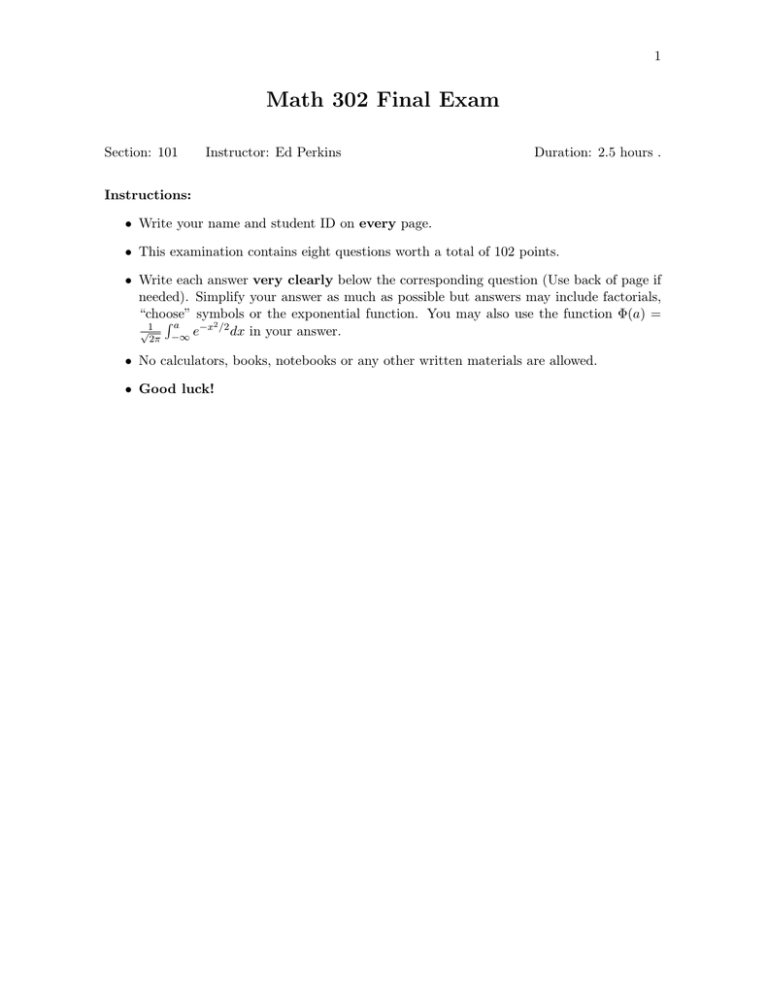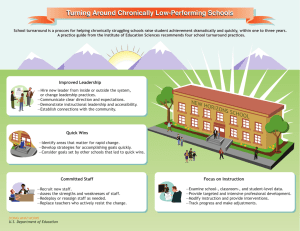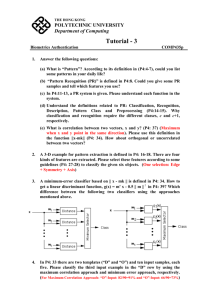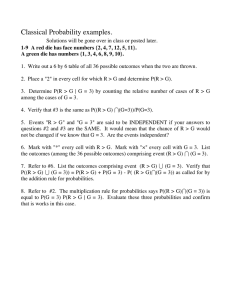Math 302 Final Exam
advertisement

1 Math 302 Final Exam Section: 101 Instructor: Ed Perkins Duration: 2.5 hours . Instructions: • Write your name and student ID on every page. • This examination contains eight questions worth a total of 102 points. • Write each answer very clearly below the corresponding question (Use back of page if needed). Simplify your answer as much as possible but answers may include factorials, “choose” or the exponential function. You may also use the function Φ(a) = R a symbols −x2 /2 dx in your answer. √1 e 2π −∞ • No calculators, books, notebooks or any other written materials are allowed. • Good luck! 2 (10 points) 1. (a) Define carefully: The cumulative distribution function of a random variable X. (b) A random variable X has cumulative distribution function 0 if x ≤ 0 x if 0 < x ≤ 1 2 1 1 F (x) = 2 + 3 (x − 1) if 1 < x ≤ 2 5 1 6 + 6 (x − 2) if 2 < x ≤ 3 1 if x > 3. (i) Find P ( 12 < X ≤ 32 ). (ii) Find P (X = 1). (iii) Find the probability density function of X. 3 (16 points) 2. Let R be the triangle in the x − y plane with corners at (0, 0), (0, 1) and (1, 0). Assume (X, Y ) is uniformly distributed over R, that is, X and Y have a joint density which is a constant c on R, and equal to 0 on the complement of R. (a) Find c. (b) Find the marginal densities of X and Y . (c) Are X and Y independent? Justify your answer. (d) Find P (Y > 2X 2 ). 4 (15 points) 3. (a) (i) Define the correlation coefficient of two random variables X and Y . (ii) Give an example of two random variables with correlation coefficient −1. (b) When flying from Vancouver to Seattle a passenger must first check in with their airline, then pass security and then clear U.S. customs and immigration. These 3 procedures take random times T1 , T2 and T3 , respectively, with unknown distributions. Past data suggests that their mean values are 15 minutes, 20 minutes and 15 minutes, respectively, and their variances are are 36, 100 and 64, respectively. Moreover, the time for check-in, T1 , is uncorrelated with the time to pass security and also with the time to clear customs, but T2 and T3 have correlation equal to 1/2. (i) Find the mean and variance of the total time T for a passenger to complete the three procedures. (ii) Using only the given information, find an upper bound for the probability that T is greater than 90 minutes. 5 (12 points) 4. (a) A and B are events such that P (A) = 0.5, P (B) = 0.6 and P (Ac ∩ B c ) = 0.1. Find P (A ∩ B) and P (A ∪ B). (b) Let X be a geometric r.v. with parameter 1/3 and Y a r.v. receiving the values 1, 2 or 3 with probability 1/3 each. If X and Y are independent, compute the probability P (X + Y = 4). 6 (16 points) 5. (a) (i) State carefully: The Central Limit Theorem. (ii) Fill in the blanks. If X is a binomial random variable with n = 1000 and p = .003, then X may be approximated by a random variable with mean . (b) A gambler pays $2 to play a slot machine. With probability .2 she wins a free drink coupon worth $2, with probability 1/200 she wins $100 and with probability 1/10, 000 she wins $5,000. She plays 100 times. (i) Find the approximate value of the probability that she wins at least 25 free coupons. (Use one of the approximating distributions in (a).) (ii) Find the approximate value that she wins at least one of the cash prizes. (Use one of the approximating distributions in (a), perhaps with different parameters.) 7 (11 points) 6. A key chain holds N different keys (N ≥ 2) and only one of them opens the door to your apartment. You try the keys on the key chain at random until the door unlocks. Let X be the number of times you tried unlocking the door. What is the probability mass function of X and the mean value of X when: (a) After trying a key you leave it on the key chain. (b) After trying a key you remove it from the key chain. 8 (11 points) 7. Let Z1 and Z2 be independent standard normal random variables. Find the following: (a) E[e3Z1 +2Z2 ]. (b) The probability density function of e3Z1 +2Z2 . 9 (11 points) 8. Suppose that X is a random variable taking on only the values 0 and 1 and that Y is a random variable taking on only the values −1, 0, 1. It is known that Var(X) = 1/4, Var(Y ) = 1/2 and E[Y ] = 0. (a) Find the marginal probability mass function of X and the marginal probability mass function of Y . (b) In addition, it is known that P (X = 0|Y = 0) = 0. Find Cov(X, Y ).




